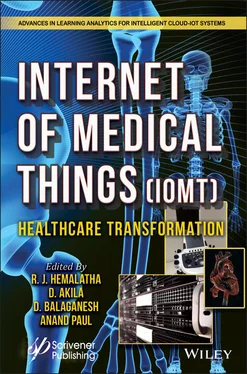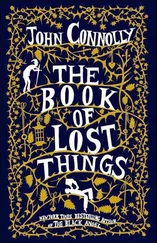The Internet of Medical Things (IoMT)
Здесь есть возможность читать онлайн «The Internet of Medical Things (IoMT)» — ознакомительный отрывок электронной книги совершенно бесплатно, а после прочтения отрывка купить полную версию. В некоторых случаях можно слушать аудио, скачать через торрент в формате fb2 и присутствует краткое содержание. Жанр: unrecognised, на английском языке. Описание произведения, (предисловие) а так же отзывы посетителей доступны на портале библиотеки ЛибКат.
- Название:The Internet of Medical Things (IoMT)
- Автор:
- Жанр:
- Год:неизвестен
- ISBN:нет данных
- Рейтинг книги:3 / 5. Голосов: 1
-
Избранное:Добавить в избранное
- Отзывы:
-
Ваша оценка:
- 60
- 1
- 2
- 3
- 4
- 5
The Internet of Medical Things (IoMT): краткое содержание, описание и аннотация
Предлагаем к чтению аннотацию, описание, краткое содержание или предисловие (зависит от того, что написал сам автор книги «The Internet of Medical Things (IoMT)»). Если вы не нашли необходимую информацию о книге — напишите в комментариях, мы постараемся отыскать её.
Providing an essential addition to the reference material available in the field of IoMT, this timely publication covers a range of applied research on healthcare, biomedical data mining, and the security and privacy of health records.
The Internet of Medical Things (IoMT) — читать онлайн ознакомительный отрывок
Ниже представлен текст книги, разбитый по страницам. Система сохранения места последней прочитанной страницы, позволяет с удобством читать онлайн бесплатно книгу «The Internet of Medical Things (IoMT)», без необходимости каждый раз заново искать на чём Вы остановились. Поставьте закладку, и сможете в любой момент перейти на страницу, на которой закончили чтение.
Интервал:
Закладка:
• Chapter 8elaborates technical architecture of IoMT in relation to biomedical applications. These ideologies are widely used to educate people regarding the medical applications using IoMT. It also gives a detailed study about the future scope of IoMT in healthcare.
• Chapter 9provides knowledge on the different performance assessment techniques and types of protocols that suits best data transfer and increases safety. The chapter provides the best protocol which helps in saving energy and is useful for the customer. It will help the researchers to select the best IoT protocol for healthcare applications. Testing tools and frameworks provide knowledge to assess the protocols.
• Chapter 10addresses the issue of a Health Monitoring Centre (HMC) in rural areas. The HMC monitors and records continuously the physiological parameters of the patients in care using wearable biosensors. The elderly suffering from chronic diseases is monitored periodically or continuously under the care of the physician. To enhance the performance of the system a smart and intelligent mesh backbone is integrated for fast transmission of the critical medical data to a remote health IOT cloud server.
• Chapter 11concentrates on Diabetes Mellitus (DM) which is one of the most widely recognized perilous illnesses for all age groups in the world. The patients need to settle on the best-individualized choices about day-by-day management of their diabetes. Noninvasive glucose sensor used to find out the glucose value of patients from its fingertip and other sensors also connected to the patient to get relevant data. A completely useful IoT-based eHealth stage that wires humanoid robot help with diabetes and planned successfully. The created platform encourages a constant coupled network among patients and their caretakers over physical separation and, in this manner, improving patient’s commitment with their caretakers while limiting the cost, time, and exertion of the conventional occasional clinic visits.
• Chapter 12explores the concepts of wearable health monitoring systems using IoMT technology. Additionally, this chapter also provides a brief review about challenges and applications of customized wearable healthcare system that are trending these days. The basic idea is to have a detailed study about the recent developments in IoMT technologies and the drawbacks, as well as future advancements related to it. The recent innovations, implications and key issues are discussed in the context of the framework.
• Chapter 13provides knowledge on biomedical big data analysis which plays a huge impact in personalized medicine. Some challenges in big data analysis like data acquisition, data accuracy, data security are discussed. Huge volume of data in healthcare can be managed by integrating biomedical data management. This chapter will provide brief information on different software that are used to manage data in healthcare domain. Impact of big data and IoMT in healthcare will enhance data analytics research.
• Chapter 14concentrates on blockchain which is a highly secure and decentralized networking platform of multiple computers called nodes. Predictive analysis, soft computing (SC) and optimization and data science is becoming increasingly important. In this chapter, the authors investigate privacy issues around large cloud medical data in the remote cloud. Their proposed framework ensures data privacy, integrity, and access control over the shared data with better efficiency. It reduces the turnaround time for data sharing, improves the decision-making process, and reduces the overall cost while providing better security of electronic medical records.
• Chapter 15discusses the evolution of electronic health record starting with the history and evolution of the health record system in the Egyptian era when the first health record was written, all the way to the modern computerized health record system. This chapter also includes various documentation procedures for the health records that were followed from the ancient times and by other civilizations around the world.
We thank the chapter authors most profusely for their contributors written during the pandemic.
R. J. HemalathaD. AkilaD. BalaganeshAnand PaulJanuary 2022
1
In Silico Molecular Modeling and Docking Analysis in Lung Cancer Cell Proteins
Manisha Sritharan1 and Asita Elengoe2*
1Department of Science and Biotechnology, Faculty of Engineering and Life Sciences, University of Selangor, Bestari Jaya, Selangor, Malaysia
2Department of Biotechnology, Faculty of Science, Lincoln University College, Petaling Jaya, Selangor, Malaysia
Abstract
In this study, the three-dimensional (3D) models of lung cancer cell line proteins [epidermal growth factor (EGFR), K-ras oncogene protein, and tumor suppressor (TP53)] were generated and their binding affinities with curcumin, ellagic acid, and quercetin through local docking were assessed. Firstly, Swiss model was used to build lung cancer cell line proteins and then visualized by the PyMol software. Next, ExPASy ProtParam Proteomics server was used to evaluate the physical and chemical parameters of the protein structures. Furthermore, the protein models were validated using PROCHECK, ProQ, ERRAT, and Verify3D programs. Lastly, the protein models were docked with curcumin, ellagic acid, and quercetin by using BSP-Slim server. All three protein models were adequate and in exceptional standard. The curcumin showed binding energy with EGFR, K-ras oncogene protein, and TP53 at 5.320, 2.730, and 1.633, kcal/mol, respectively. Besides that, the ellagic acid showed binding energy of EGFR, K-ras oncogene protein, and TP53 at –2.892, 0.921, and 0.054 kcal/mol, respectively. Moreover, the quercetin showed binding energy of EGFR, K-ras oncogene protein, and TP53 at –1.249, –1.154, and –0.809 kcal/mol, respectively. The EGFR had the strongest bond with ellagic acid while K-ras oncogene protein and TP53 had the strongest interaction with quercetin. In order to identify the appropriate function, all these potential drug candidates can be further assessed through laboratory experiments.
Keywords:EGFR, K-ras, TP53, curcumin, ellagic acid, quercetin, docking
1.1 Introduction
Lung cancer is known to be the number one cause of cancer deaths among all the cancer in both men and women in worldwide. According to a World Health Organization (WHO) survey, lung cancer caused 19.1 deaths per 100,000 in Malaysia, or 4,088 deaths per year (3.22% of all deaths) [1]. Moreover, there was a record of 1.69 million of deaths worldwide in 2015 due to lung cancer. Furthermore, a research in UK estimated that there will be 23.6 million of new cases of cancer worldwide each year by 2030 [1]. The main cause of lung cancer deaths is smoking. Almost 8% of people died because of it. Furthermore, the second reason is exposure to secondhand smoke. Thus, it is very clear that smoking is the leading risk factor for lung cancer. However, not everyone who got lung cancer is smokers as many people with lung cancer are former smokers while many others never smoked at all. Moreover, radiation exposure, unhealthy lifestyle, secondhand smoke, pollution of air, genetic markers, prolongs inhalation of asbestos, and chemicals as well as other factors can cause lung cancer non-smokers [2].
Furthermore, it seems that most lung cancer signs do not appear until the cancer has spread, although some people with early lung cancer do have symptoms. Generally, the symptoms of lung cancer are a cough that does not go away and instead gets worse, shortness of breath, chest pain, feeling tired or weak, new onset of wheezing, and some lung cancer can even cause syndrome [3]. On top of that, a number of tests can be conducted in order to look for cancerous cell such as X-ray image of lung that could disclose the abnormal mass or nodule, a CT scan to exhibit small lesions in the lungs which may not detected on X-ray, blood investigations, sputum cytology, and tissue biopsy [4]. Lung cancer treatments being carried out are adjuvant therapy which may include radiation, chemotherapy, targeted therapy, or immunotherapy.
Читать дальшеИнтервал:
Закладка:
Похожие книги на «The Internet of Medical Things (IoMT)»
Представляем Вашему вниманию похожие книги на «The Internet of Medical Things (IoMT)» списком для выбора. Мы отобрали схожую по названию и смыслу литературу в надежде предоставить читателям больше вариантов отыскать новые, интересные, ещё непрочитанные произведения.
Обсуждение, отзывы о книге «The Internet of Medical Things (IoMT)» и просто собственные мнения читателей. Оставьте ваши комментарии, напишите, что Вы думаете о произведении, его смысле или главных героях. Укажите что конкретно понравилось, а что нет, и почему Вы так считаете.












